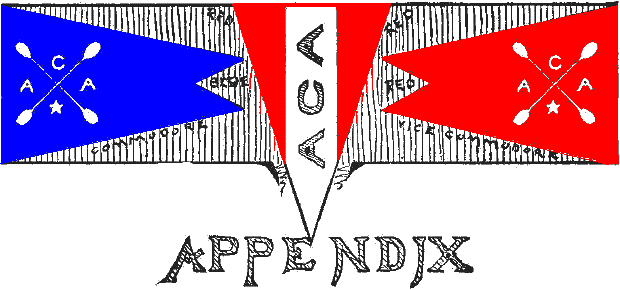
APPENDIX (II).
The American Canoe Association is now made up of divisions, each one of which has a yearly meet. The general ACA meet is held in the territory of each division in successive years. The division meets are more or less local, and occupy from three days to two weeks time. The general meet is always for two weeks; the regatta and trophy, or championship, races occur the second week. The first week is devoted to cruising and general fun, and scrub races.Besides the regular class sailing and paddling events that always find a place on the regatta programs, there are other races that perhaps call for a word of advice.
Any canoe is allowed in the upset race. The lighter a canoe is, and the finer the lines, if of the usual length, the easier it is to paddle. A small cockpit takes up less water than a large one when the canoe is turned completely over quickly. The two points to be kept in mind in an upset contest are: the paddling fast at the beginning when no water is in the canoe, to get as great a lead as possible, and the getting in quickly after the canoe is turned over. The upset part can be done in five seconds by a skillful hand at the business.
It is much easier to upset and right a canoe under sail when heading well up into the wind than when running free, as the wind pressure on the sail is less in bringing the canoe to an even keel after the roll over. If running with a beam wind when the signal to upset comes, luff the canoe up almost into the wind before upsetting it, and thus relieve the sail of pressure.
With two bulkheads five or six feet apart, a canoe can be upset under sail, righted, and then float with deck well above water, and bailing out is possible. Generally in an upset sailing race it is not worth while to hail out, as the distance to be covered is too short.
In the recover race, where a half paddle is thrown overboard well aft, it is better to jibe first than to tack and then jibe to get back to the lost article. It takes less time and is surer to jibe first and then tack. Try it and see for yourself.
More practical knowledge can be obtained by attending a two weeks' canoe meet of the ACA than by reading all the articles and books on the subject ever written. The builders go there to get new ideas; and every canoeist, no matter how well informed in the matter of rig and handling, learns something from his neighbors. The cost is slight; the time, a regular business vacation; the fun immense, and the profit great, both in point of health and canoe information.
• • • Since this book was first published the International Races of 1886 have taken place. Those races, in which two of the crack English canoe sailors took part, proved many things finally. Both Englishmen and Americans learned something. The Americans discovered that the sit of the British sails, the rig, cordage and fitting of the foreign canoes far outdid anything the Americans could show. They learned also the advantages of a smooth skin canoe perfectly polished. The flying start in sailing races, timed with stop watches to a second, enabling a canoe to cross the line at the signal near the windward mark and under full headway, was much better than the old methods adopted at ACA races. This trick the Englishmen had down to the finest possible point. The lead at the start in a sailing race is a very good thing to get -- and hold.
The Englishmen found out that their bulky canoes with heavy ballast and heavy centerboards carrying large sails and crew inside were no match in point of speed for the light and slim canoes of the Americans, carrying little or no ballast, having very light plate centerboards, comparatively small spread of muslin and crew on deck to windward. Since those races nearly every sailing canoe built here is fitted with a plate centerboard housed in a wooden or metal trunk. The use of ballast has greatly diminished, and speed with the smallest sail spread is aimed at. Light spars, simple rig, a large drop rudder, fine lines, flat sails, perfect trim and skillful handling are depended on to accomplish great results, and they have done it, with the help of a smooth finish on the canoe's bottom to reduce skin friction to a minimum. This last is a very important item.
A heavy canoe heels over before the speed is increased when a squall strikes the sail. A puff of wind will instantly increase the speed of a light canoe, and consequently heels it over less. It is for this reason that many very light canoes seem actually stiffer than heavily ballasted boats.
Light canoes needing no ballast, and carrying simple small rigs, are so much more convenient than the heavier craft that it was only needed to show them better in point of speed to entirely run out the old style sailing machines, as some extremists have been pleased to call them. The heavy canoe is fast disappearing, except in sizes larger than Class B.
• • • Great improvements in all sorts of canoe fittings have been made since the first edition of the book appeared, and builders generally can now furnish excellent plate boards, good cleats, neat rudder hangs and drop rudders, to say nothing of all the beautiful "canoe jewelry" made for mast and spar fittings. The best rudders are hung so that there is no "dead water" between rudder and sternpost, and they are arranged to drop easily, or be run up out of the way if necessary, so that a canoe can be beached stern first without damaging the gear.
A rockered keel is almost universal now, enabling quick turning, where the old straight and flat keel was formerly used. The trim of a canoe depends on the disposition of sail area, the position of the centerboard and ballast, if any is used -- three things. The position of the board is fixed when the canoe is built, as near the center of the canoe as convenience will allow. Then the sail area is designed with reference to the board, and arranged to balance as nearly as possible by the light of former experience. The ballast or crew can be shifted to perfect the trim. The greatest speed can only be got out of a canoe when it is balanced -- in perfect trim in other words .
After a yacht is built it often takes months to get the trim perfect, and this is accomplished by close observation when the yacht is sailing, and constant experimenting with ballast. The same must be done in a canoe. Slight changes in sails may help greatly to arrive at the best results. No positive rules for trim can be given. The general methods of handling canoes, as all other boats, must necessarily always remain pretty much the same. Paddling cannot change; it is a simple performance, and is now -- what it always has been. The model of paddles may change a little, the length and make, but the action of paddling is not capable of much, if any development. Sailing is sailing and likewise cannot undergo much modification. The rules of the road remain the same from year to year, and the action of the wind is what it always has been. Rigs and the cut of sails may undergo slight modifications to gain a half a point here or a pound of pressure there, but the principles remain unaltered.
As some modifications of the sails described in the text have proved themselves worthy of a place in a book on canoe handling and rigs, they will be here touched on lightly.
When a man over seventy years old builds a canoe himself, cuts and rigs his sails and makes all the fittings, the fact is worthy of note. But when this same canoe and man come to a general canoe meet, and carry off all the sailing honors from a fleet of thirty crack canoes, the man and boat deserve more than a passing word of comment. The man is N.B. Cook of Chicago, the boat the Kenwood, and the feat was performed at the Western Canoe Association meet at Ballast Island, Lake Erie, July, 1887.
The sails were laced to the mast. The peak was held up by a sprit running to boom instead of to mast as is usual with spritsails, thus keeping all flat and preventing the boom from lifting. The objection to the sail is that it cannot be reefed, a fatal objection to any sail intended for general use, and not designed for a special kind of racing and water.
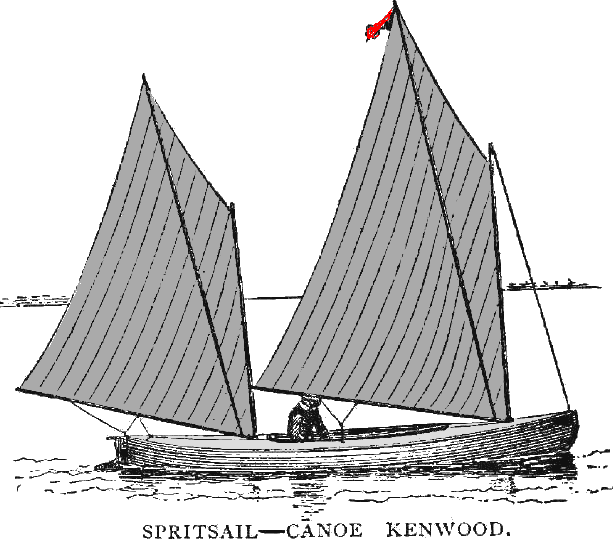
SPRITSAIL-CANOE KENWOODNo one has been more influential, perhaps, since the revolution brought about by the man who first sat on the deck of a canoe to sail it, in changing the general tendency from large rigs and big boats to small craft and light rigs, than Mr. Barney, of Springfield. His canoe, the Pecowsic, and her appearance and performance at the '86 ACA meet were the talk of the canoeing world for over two years in England, Germany and America. The Pecowsic had fine lines, was a narrow and long canoe, and was fitted with modified mutton sails laced to the mast (shown in the illustration). The canoe was first sailed with three masts and sails, but did not prove successful. Afterward two sails were used with wonderful result. The canoe had five sails of different sizes, all interchangeable, only two being used at one time -- which two depended on the power of the wind. This arrangement did not and cannot prove popular for obvious reasons. It is a racing expedient, and perfectly allowable as such. The sails can be shifted when the canoe is sailing, but it takes more time to do it than it would to reef an ordinary sail.
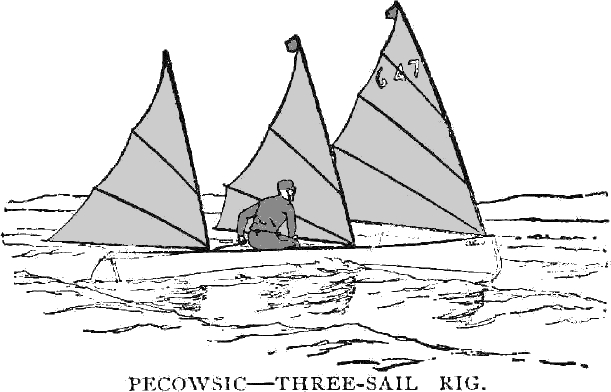
PECOWSIC-THREE-SAIL RIG
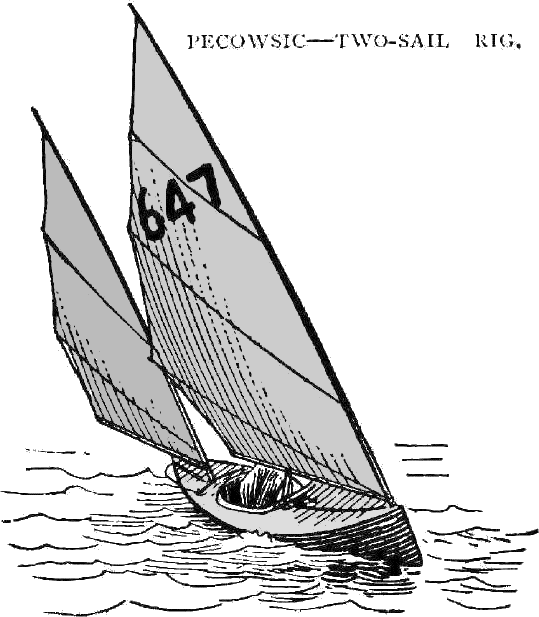
Both the Cook and Barney rigs grew out of the desire of each to get the best windward sail possible, for (as before explained) the best canoe to windward always stands the greatest chance of winning the races. That part of the sail which is forward of the mast in the balance lug, standing lug and Mohican sails does little good, and prevents close pointing. As this fact became more and more apparent to canoeists, means were taken to overcome it. The sail used on Lassie in the International races (see page 159) had only about four inches of surface forward of the mast and peaked tip very high, and was therefore a great improvement on the old balance lug.
The best of lug sails have weak points. As the sail has to be against the side of the mast, and therefore not exactly in the middle of the canoe, the boat always sails a little better on one tack than the other, which is a very had point. For the best windward work a leg of mutton sail is needed. It is all aft of the mast and in the middle of the canoe therefore. It has no peak to fall off from the wind and thus render a part of the sail ineffective. The pull on the boom when the sheet is belayed gives a direct strain on the leach of the sail from boom end to top of mast, flattening the sail down perfectly and keeping its entire surface in one plane. All gaff and yard sails when close-hauled take the form of a warped surface (as the figure is described in the geometries) and for canoe sails they have practical disadvantages therefore. The objection to the leg of mutton sail is its extremely high mast and comparatively small amount of sail surface spread by it.
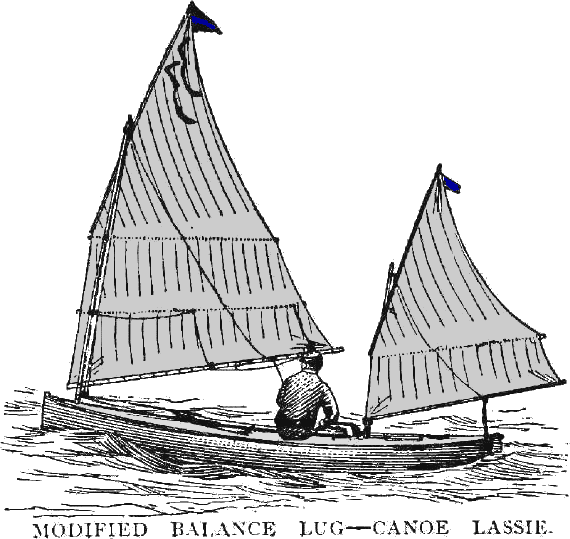
The new sail described below overcomes this objection by converting the ordinary yard or gaff into a sort of topmast, somewhat similar to the sliding gunter rig experimented with and discarded in the early days of canoe sailing. The batten in the lower part and great roach in the head of the sail give a good spread without running the peak up too high. The sail can be made lower by the use of more battens, but their use does not improve it.S.R. Stoddard invented and used on his canoe Atlantis, during the last year of his famous voyage up the coast to the Bay of Fundy, a sail that has many of the advantages of the Barney and Cook gears, and has an added virtue -- it is capable of being reefed. It is a close windward sail, with comparatively short spars, and has, since its introduction, been quite generally used by canoeists, often modified in form in various ways. A modification of the Dot reefing gear (before described) has been applied to this sail, and it works so satisfactorily that there seems nothing more to be desired in this direction.
The sail (see page 163) and gear are worth the careful study of all canoeists desiring a handy rig, convenient, safe, and yet having all the elements of speed and close windward points. The cloth is all aft of the mast. One batten only is used The end of the yard hinges on the batten, and a fork about the mast holds yard and batten in place. The halyard gear is just the same as on a balance lug sail -- ring on mast. A peak halyard can be used when the sail is reefed, but it is hardly necessary.
ATLANTIS-SAIL REEF GEAR
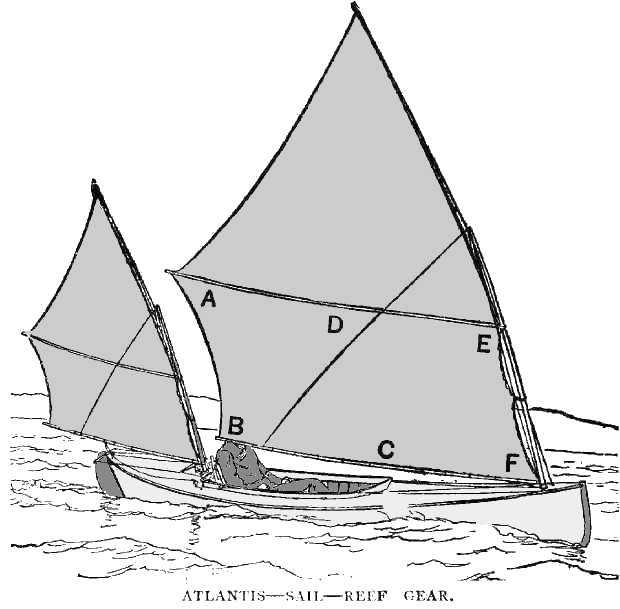
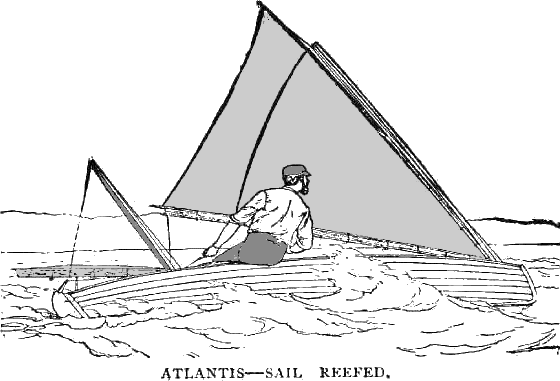
The yard should be made with its greatest diameter a foot or two above the mast (when sail is hoisted) and tapered off toward its ends. A great deal depends on the shaping of the yard and the roach of the sail.
The reef lines (not shown in drawing) run on both sides of the sail, through a hardwood thimble at foot of mast and aft to skipper's hand. One line is fastened to batten at point A, runs down sail through three rings served to sail, to B, where there is a thimble lashed to boom, through the thimble, along boom to C (thimble) up to D, (there are no rings between C and D as they are not needled) through D (thimble) along batten to E (thimble) down sail (through three rings) to thimble at foot of mast and then aft.
The other line follows the same course on the other side of the sail. When these two lines are drawn in (the halyard of course being slack) they bring batten and boom together with a direct pull, and fold the sail very neatly and compactly between them. Shrinking of reef lines does not affect the working in the least.
The whole rig is very simple. Hard wood thimbles are much better than blocks for reefing gears (they should be soaked in oil before they are used) and can now be got of the dealers. The reefing lines, thimbles, etc., should be kept lubricated always to run smoothly. Vaseline is an excellent rig lubricator. The rings between battens are sewed in and reef lines run through then to keep the edges of the cloth from flapping about when a reef is taken in. The reef is much neater with them than without. Perhaps a better sail and rig will be invented than this one, but it is difficult to imagine such a thing.
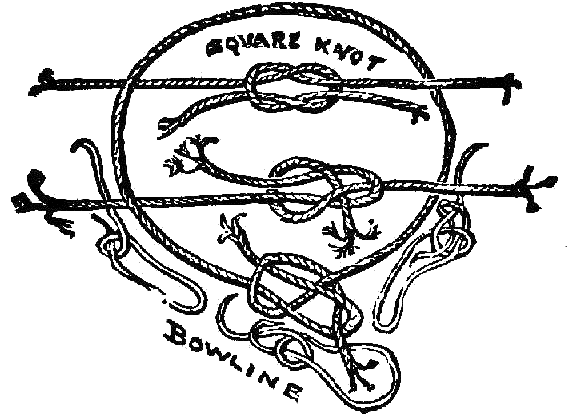
© 2000 Craig O'Donnell
May not be reproduced without my permission.
